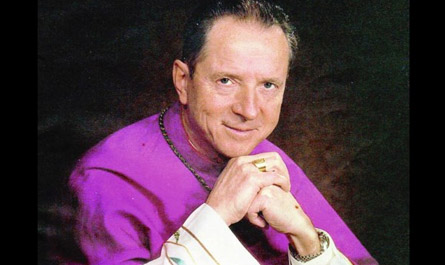By Steve Raml, Director of Liturgy & Music
Principled Liturgy
For the first half of my adult life, I was a journalist, specifically a TV and Radio reporter and news anchor. In the second half, I’ve enjoyed a two-decade career working for the Church in the areas of music and Liturgy.
At one point, these two worlds intersected and I had the opportunity to have an extended interview with Canadian Bishop Remi de Roo (pictured above). Bishop Remi (as he invited me to call him) was the youngest bishop to attend the many sessions of Vatican II in the early 1960’s.
Bishop Remi spoke at length about the impact the Council had on our Church. His thoughts on the various constitutions and documents on everything from how we view ourselves as a Church – to how we read the Word of God – to how we act in the Modern World provided great insight on how the Council set in motion the reforms of Catholic teaching.
When most people think of Vatican II, they focus completely on the changes in the Liturgy. Perhaps this is because the Mass, our celebration of the liturgy, is the one activity we have in common, so we all have an opinion on it.
Remembering my conversation with Bishop Remi, I reflected on what I learned as the guiding principles of the first Vatican II document – the Constitution on the Sacred Liturgy. Here are what I see as the key principles to follow when preparing for and celebrating the Mass:
The Liturgy is the Action of Christ. It does not belong to any one individual or group, or even just to those of us living today. The liturgy belongs to Christ, who is present in a variety of ways: in the baptized members of the Church who gather for worship (both assembly and priest), in the proclamation of the Word and in the sacramental elements of the bread and wine in the Eucharist. (CSL # 7) Christ has been present in the liturgy throughout the ages, and is truly present with us today.
Full Participation in God’s Divine Plan Stems from and leads to Full Participation in the Liturgy. Christ established the Church to spread the Gospel through word and action (Matthew 28: 19-20). The liturgy is the “primary and indispensable source from which the faithful are to derive the true Christian spirit” (CSL # 14) which leads to participation in the Church’s mission. Therefore, “full and active participation by all the people is the aim to be considered before all else” (CSL #14).
Full participation is both internal and external, for if we are to be the “Body” of Christ, we need to fully “embody” our worship, prayer, devotion, petition, celebration, sorrow and rejoicing. We need to hear the Word of God with our ears and respond to it with full voice. We need to savor the Eucharistic elements which we take into our bodies. We need to feel the cleansing power of water, the smooth anointing of oil, and the touch of hands invoking the Holy Spirit. All of those ritual actions involve our whole body.
The Liturgy is the Font and Summit of the Church’s Activity. The liturgy calls us to authentic Gospel living. Just as our hearts and minds are transformed in the Eucharist through God’s grace, we are called to respond to that grace and move beyond the walls of our church and transform our world with love and healing. (CSL #10) Pope John Paul II made authentic Gospel living a measure of the effectiveness of our liturgy: “By our mutual love and in particular by our concern for those in need, we will be recognized as true followers of Christ. This will be the criterion by which the authenticity of our Eucharistic celebrations will be judged.” (Mane Nobiscum, Domine, 2004)
The Church is One Body with Many Ministries. The primary liturgical ministry is that of the assembly, the Body of Christ. As we sing, “we are many parts, we are all one body”; and like any body, the parts perform various tasks for the good of the whole, which we identify as ministries. These specialized ministries include the ordained (bishops, priests, deacons) and baptized members called to the ministries of Lector, Extraordinary Minister of the Eucharist, Hospitality, Music and others.
The goal of each ministry is the action of the whole Body of Christ sharing in prayer, praise and thanksgiving. Each ministry has both responsibilities and limits. Each individual should perform everything required of their role, but only that which is required, “with the sincere devotion and decorum demanded by so exalted a ministry and rightly expected of them by God’s people.” (CSL #29)
Music is an Integral Part of the Liturgy. Music unites our voices to proclaim the texts of the liturgy in such a way that it “adds delight to prayer, fosters unity of minds, and invests the rites with greater solemnity.” CSL # 112) Music contributes to the complex set of symbols that make up our liturgical celebration. Music’s purpose in the liturgy is the same as the liturgy itself: “the glory of God and the sanctification of the faithful. (CSL #112)
The Bishops of the United States took this up in a series of documents on Music in the Liturgy. The most recent, “Sing to the Lord” reminds us that: “This common, sung expression of faith within liturgical celebrations strengthens our faith when it grows weak and draws us into the divinely inspired voice of the Church at prayer. Faith grows when it is well expressed in celebration. Good celebrations can foster and nourish faith. Poor celebrations may weaken it.” (STL #5)
These are the principles I’ve gleaned from both study and experience in celebrations of the Mass. They are the principles I strive to follow as I work with the ministries here at St. Elizabeth Seton.
Steve Raml
Liturgy & Music Director

